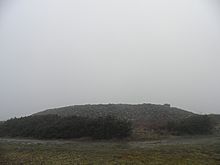|
|
|
|
CarntighernaCairn(s)
|
||||||||||||||||||||||||
|
|
|
Images (click to view fullsize) |
|





|
Fieldnotes |
|
|
This cairn is on top of a prominent hill just outside the town of fermoy in Co. Cork. Anyone taking the M8 from Dublin to Cork will probably have noticed its prominent cross while passing. This seems to be another Christainised hill in Ireland. The hill is home to this huge cross on top and a "stations of the cross" walk. A sign-post on the way up to the hill reads that "stations" take place every friday morning on the hill still. Along with the stations this hill has some great walks and now seems to be widely utilised by walkers, dog-walkers and there were some guys getting ready to go moutain biking as I was leaving. I had an older version of the OS map without the M8 on it and so finding the correct route up was a little trickier. Basically the road to the main car-park is south of the two roundabouts up onto the M8 using an overpass of the M8 (If that makes any sense) The walk from the car-park to the cairn on top is about 20 mins. I went left up the hill (which is shorter and I think follows the "station" route) rather than right which takes you on a longer walk to the top. The cairn on top is very impressive, I from The Ballyhoura Hills Project it measures 40m (east-west) by 26m (north-south) and height 4m. Seemingly it is much robbed with its stones being used for a boundary around the hill and the cross itself which was built to commemorate the 19th century of JC's death. It was also excavated in the 1830s when they found a cist within. It was a double-compartmented cist which contained pottery vessels. The cist was found after moving hundreds of tons of stone. One chamber contained fragments of a vessel for food and the other ashes. There current location is unknown. A WWII lookout post or bunker was also built into it. |
14th March 2011ce Edited 14th March 2011ce |
Folklore |
|
|
From the information board "Around 3000 years ago cairns, "mound of stones" were erected to mark the burial place of important individuals. This bronze age cairn is one of a number, which occupy prominent positions on the hilltops of the Nagle Mountains, stretching westwards from Fermoy to Mallow. The cairn has been much abused over time. During World War I the British Army built an observation bunker inside it and the Irish Army did likewise during World War II. 100 years ago the cairn was twice as high as it is now and in 1832 "several hundred tons of stone" were taken from the cairn to build a nearby boundary wall. In the process the workmen disturbed a double-compartmented cist (stone grave). Inside were two bronze-age earthenware vessels, containing the cremated remains of at least one individual. One of the vessels was broken by workmen to see if there was treasure insidem the whereabouts of the other remains unknown. According to legend, Cormac Mac Airt, High King of Ireland in the 3rd Century AD arrived in Munster to demand tribute. When Cormac's army was fiercely resisted by the Munstermen, his Scottish druids cast spells over the land so that the wells, dried up and both man and beast suffered. The Munster King, Fiachaidh Muilleathan, appealed for help to the infamous druid, Mogh Ruith, who cast spells so strong that Cormac's army retreated in disarray and confusion. When the druid came to claim his reward "two thirty hundreds of the fairest land in Munster" - he choose the Blackwater Valley, the ancient land of the Caoilli. The druid Mogh Ruith is said to be buried under the cairn on Corrin Hill. According to legend a fable cow, the Druimionn, used to graze the slopes of Corrin producing milk to feed Giants. A mysterious quadruped, called the Lon, used to waylay the magic cow in the marshes at the foot of the hill and take her milk. The giants tried in vain to capture and kill the Lon but eventually they summoned the hero, Finn MacCool and his famous hound Bran. Bran tracked the Lon to its lair and finally killed it after a savage fight. Another legend relates that long ago the king of Fermoy had a son whose death by drowning was foretold. He decided to build a castle on top of the hill to house the boy and keep him safe from rivers and lakes. One day, while the castle was being built, the young prince walked by a barrel of water that was left there by the builders. He had never before seen his reflection and peered into the barrel for a closer look. When the King turned around he found his young son drowned, face down, in the barrel. He cursed the place and abandoned work on the castle." |
14th March 2011ce |

